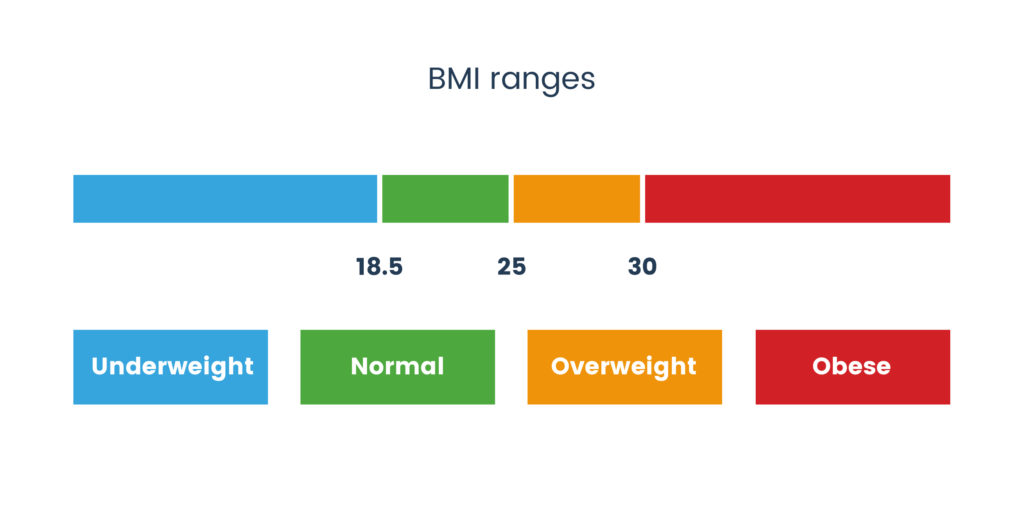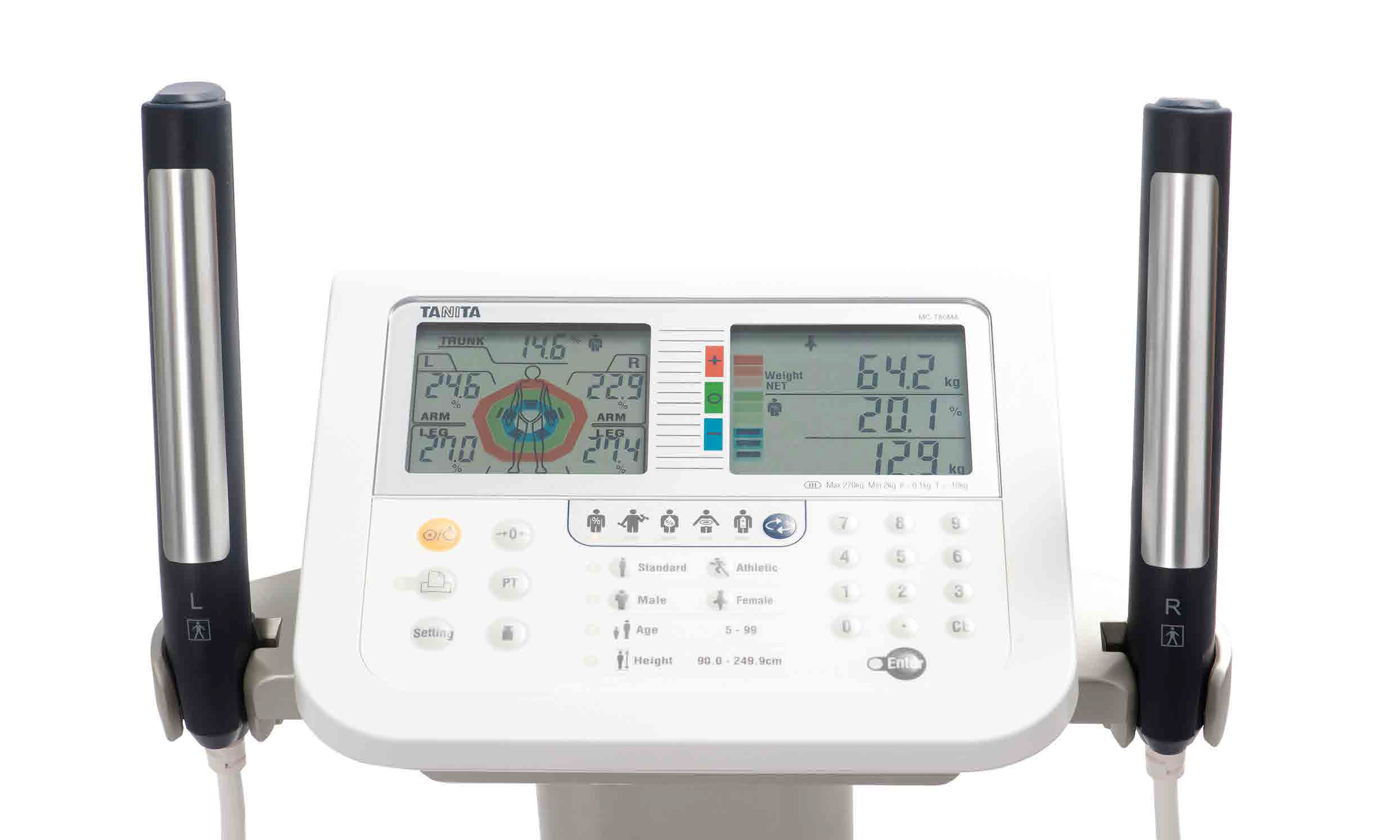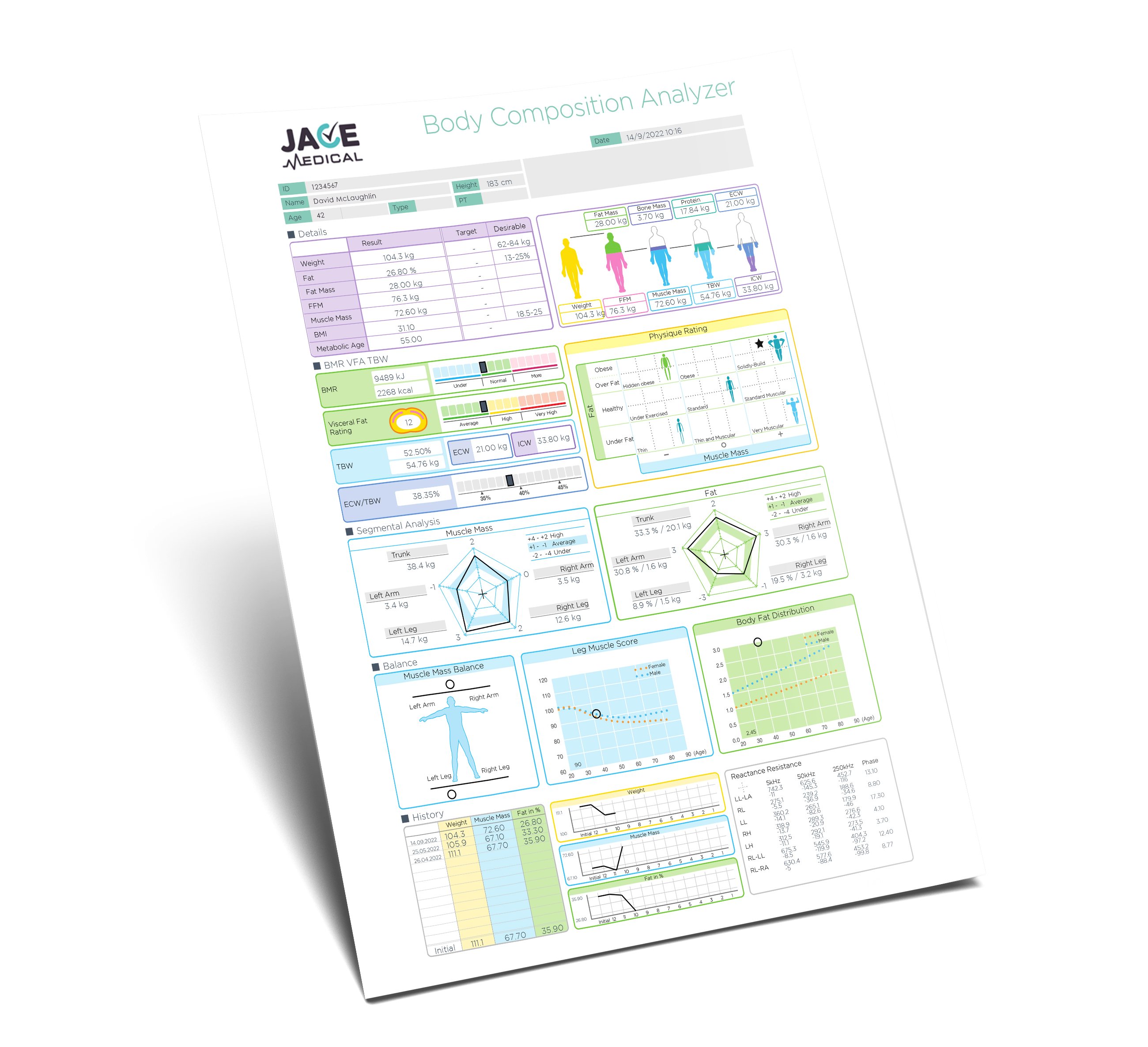Understand & Improve your Health with a
Body Composition Analysis
Our body composition analysis provides a clear picture of your health
Our body composition scales go way beyond measuring your weight. Using our advanced technology, our monitors map out your body composition. Our body composition monitors provide insight into more than ten different measurements. With these measurements, you get a much more complete picture of your own health. This clear picture is a good step towards an (even) healthier life. You see exactly where you can still make progress and adjust your diet, training schedule or lifestyle accordingly. To properly interpret and effectively use the measurements of our body analysis scales, it is important that you understand what they mean.
We email you a detailed report
After your scan we send you a detailed report with a break down of your results.
Read the section below or download a factsheet here to understand each measurement. You may wish to schedule another analysis in the future to monitor your health and wellbeing over time.
Understanding your measurements
Body fat & Segmental mass and percentage
The body fat mass is the weight of fat in your body. The body fat percentage is the weight of the body fat mass in relation to the total body weight.
Body fat fulfills important functions, such as keeping your body warm or protecting your organs. It’s important, but an excess or shortage of fat is counterproductive for your health. A high percentage of fat can lead to lifestyle diseases such as type 2 diabetes or obesity, while a low percentage of fat can lead to osteoporosis, irregular menstruation or loss of bone mass. Our body analysis scale helps measure body fat percentage, by calculating your body fat in relation to your total body weight. A too low percentage means you probably need to make changes to your diet and exercise regime to increase your fat mass to a more healthy level, while a high percentage means you could benefit from more exercise and a healthier diet.
Body fat percentage – are you at a healthy weight?
Your body fat percentage is essential to know when evaluating your health. It divides your total weight in two categories: fat mass and everything else. You need fat to keep you warm and to protect your organs and joints. However, it is not healthy to have too much or too little fat.
If your body fat percentage is too low, your resistance to diseases and energy levels are lower, and you are at at risk of health issues.
If your body fat percentage is too high, you have a higher risk of diabetes and other health problems.
It is therefore important to measure your body fat percentage, and stay in the healthy range.
Segmental body fat percentages
Is the fat in a certain body part bothering you especially? A Tanita Body Composition Monitor can also measure segmental fat percentages for your core and each of your arms and legs separately. Keep in mind that it is not possible to lose weight from a specific body part only. If you exercise and eat below your maintenance level, you will lose fat all over. However, the way fat is distributed differs between different people and body types.
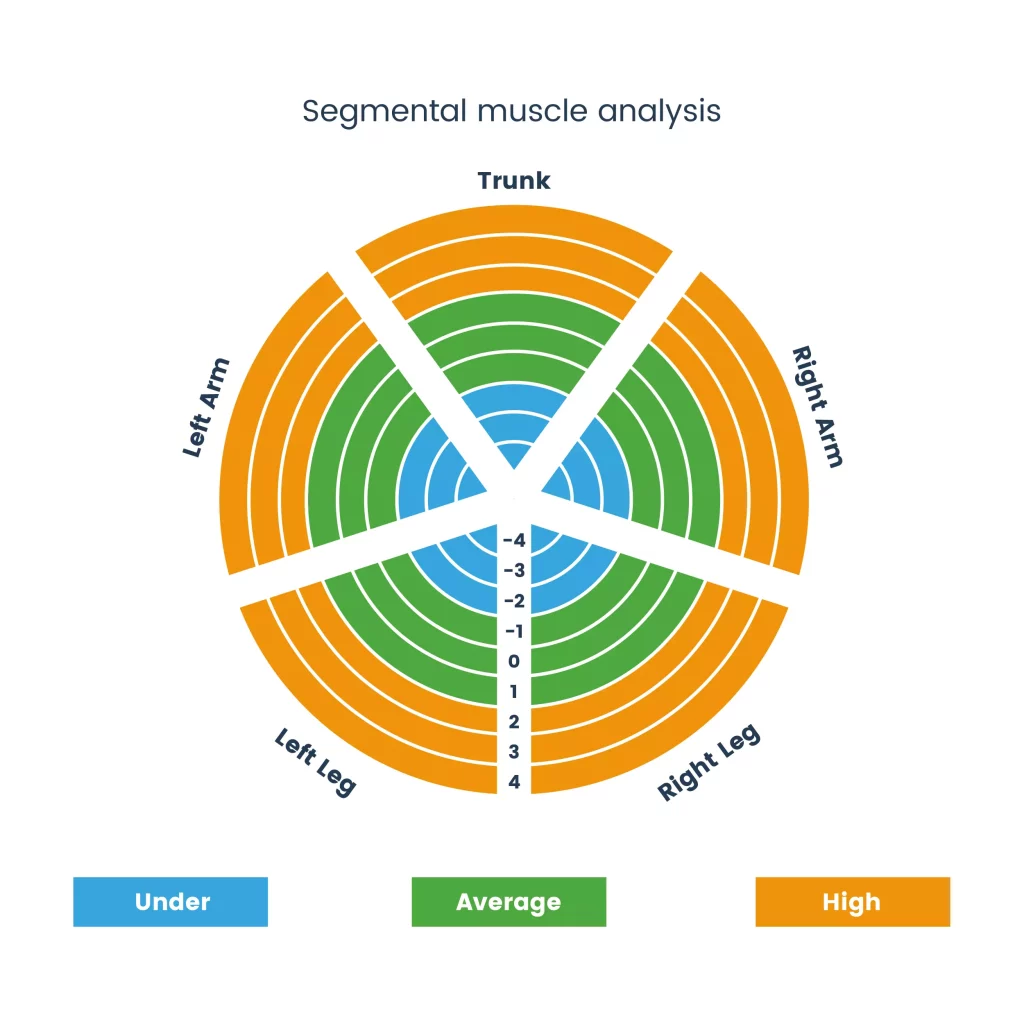
What is a normal body fat percentage?
When you have measured your body fat percentage, you can compare it with the healthy body fat ranges in order to find out if you have a healthy body fat percentage. These measurements are available for several age ranges.

Visceral fat
Visceral fat is found deep in the core of the abdomen. This fat surrounds and protects vital organs, such as the liver, pancreas and kidneys.
Visceral fat is on the inside of the muscle wall in the body’s trunk and protects vital organs. Visceral fat is not visible on the outside of the body and you cannot squeeze it. In addition to a healthy overall body fat percentage, it is important to keep a close eye on the amount of visceral fat. Especially as you get older. Too much visceral fat can lead to serious health problems, such as cardiovascular disease, type 2 diabetes or hypertension. Our body analysis scales provide insight into the amount of visceral fat.
A lean belly leads to a healthier life. When measuring your body fat surrounding the waist, you are actually measuring visceral fat. This is the fat that surrounds your abdominal organs. It is normal to have some visceral fat; however, a high level of visceral fat can lead to serious health issues.
What is visceral fat?
Compared to ‘normal’ fat, visceral fat is stored deeper in the skin. Visceral fat is wrapped around major organs like the liver, pancreas and your kidney. Visceral fat ensures that there is some distance between each organ. Too much visceral fat creates can lead to inflammation and high blood pressure, which increases the risk of serious health problems. This is also know as central obesity.
Another problem with visceral fat is its impact on adiponectin or ‘fat hormone’. Adiponectin’s function is to regulate your body fat. Visceral fat inhibits adiponectin. As a result your body produces more fat than you actually need. A high level of visceral fat also influences your insulin sensitivity. Which means that it can lead to type 2 diabetes later in life.
How to measure visceral fat?
There are many different ways to measure visceral fat, these include options you could do at home, but you could also go to your doctor. An easy method you could do right now is to take a measurement of the largest parts around your waist and hip. However, this option is not entirely accurate. Once you have measured both your waists and hip, divide the waist by the hip measurement. A healthy body should have less than 1.0 for men or 0.85 for women.
A good indicator of having a high level of visceral fat, is a high BMI score (Body Mass Index) and a large waist. If you have both, chances are likely that you have a high level of visceral fat.
By now you should be aware of the dangers of having to much visceral fat. But our body consists of more than only fat, take muscle mass for example. And right here a Tanita weighing scale is your friend . Our body composition monitor can exactly measure your visceral fat. Because it is more than just a visceral fat scale. It measures your entire body, it gives detailed information on your body’s composition. Getting a detailed overview of what your body is made of will help you to adopt that healthy lifestyle.
Practical tips on how to lose visceral fat
- Get enough sleep
- Exercice on a daily basis
- Try to reduce high amounts of stress
- Follow a balanced diet with healthy protein choices
- Reduce you alcohol consumption
- Quit smoking
What is the ideal visceral fat rating?
The body composition analyser can track visceral fat in your body. Based on all the available information it gives you a range between 1 and 59. A rating between 1 and 12 indicates that you have a healthy level of visceral fat. A rating between 13 and 59 indicates that you have an excessive level of visceral fat.

Common questions about visceral fat
How dangerous is visceral fat? Visceral fat can be dangerous due to the fact that it is implicated in a number of chronical conditions such as cardiovascular disease, dementia and breast cancer. Harvard health discusses the link of visceral fat and these chronical conditions. Can stress cause visceral fat? Stress can play a role in the degree of visceral fat. When a person is stressed, the body produces a hormone called cortisol. This hormone increases the amount of visceral fat stored in the body. Which foods should you avoid to reduce visceral fat?
- Fried foods
- Refined carbohydrates
- Baked goods
- Foods and drinks with added sugar
Can visceral fat cause pain? Visceral fat can cause pain because it produces more of certain proteins that inflame your body’s tissues and organs. This can lead to pain in the gut.
Muscle mass & Segmental muscle mass
The predicted weight of muscle in your body.
Muscle mass includes skeletal muscle, smooth muscle (such as heart and digestive muscles) and the water in your muscles. Muscles act as the engine for your energy expenditure. As your muscle mass increases, the rate at which you burn energy (calories) increases. This speeds up your basal metabolic rate (BMR) and helps to reduce excess body fat. This is how you lose weight in a healthy way.
A high muscle mass can reduce the risk of developing diabetes in adulthood. More skeletal muscle mass means more insulin receptor sites, which help with the uptake and regulation of glucose (sugar) deposited in the bloodstream after eating. 80% of glucose uptake takes place in skeletal muscle. The more skeletal muscle mass there is, the easier it is for the body to regulate insulin levels and minimise excess fat.
In the elderly, muscle mass is particularly important for maintaining mobility, supporting the joints and maintaining good balance, thereby helping to minimise the risk of falls and fractures. A good or high level of muscle mass is an important indicator of longevity.
What is muscle mass?
To manage your muscle mass and body fat percentage you first have to understand your measurements. Often people mistake building muscle mass with burning body fat. These two often go hand in hand, but they are not the same. Muscle mass includes the weight of the muscles in your body in kilograms or pounds. While the body fat percentage measures the amount of fat your body holds. Burning body fat can be a result of the accumulated muscles. Muscles are like engines when it comes to consuming energy. Our muscle mass plays a crucial role when it comes to fitness. When your body builds muscles, it burns energy and fat all the time. As your muscle mass increases, the faster your body is able to burn calories/energy. This leads to an increase of your basal metabolic rate (BMR), which helps in losing weight. Muscle mass includes smooth muscles, skeletal muscles and water contained in the muscles. Where the skeletal muscles are the most visible when there is no fat layer. Muscles consist of water and protein. This is why it’s important to include protein in your adjusted eating schedule.
How to gain muscle mass
There is a difference between gaining muscle mass for men and women. Men have a higher muscle production than women; often this is used as an excuse when it comes to growing muscle mass. This does not mean that women cannot gain muscle mass. In fact, women can experience big gains in power and muscle mass as well and they should train their muscles the same way as men do. Building muscle happens in the gym, but also in the kitchen. Building muscle mass is not only about going to the gym and lifting, you can also build cycling by other types of workouts, such as cycling. There is also another an important rule to remember: eating for muscles is just as important as lifting. Combine training with eating well. But how do you make sure you eat enough to build muscle? First, you need to know how many calories you need in rest mode. You do that by calculating your Basal Metabolic Rate. Then you make sure to eat more than this. Keep track of the results. If you are training, but your fat levels are going up, lower your caloric intake. If you stay slim, but do not make any progress in the gym (and thus not gaining muscle mass) make sure you eat more. The most accurate way to measure muscle and body fat levels is using a body composition monitor. What you eat is also important when trying to gain muscle mass. Keep track of the ingredients you are consuming: not only the amount of calories, but also the nutrients in them. In general: eat healthy, varied, eat often and avoid junk food. To build muscles, your body needs protein. Therefore it is important to include lots of proteins in your new diet. Think about products like chicken, turkey, yogurt, beans, nuts and different kinds of fish. However, don’t forget you also need carbohydrates and healthy fats. Keep your diet varied and eat enough vegetables in addition to the protein-rich food in order to gain muscle. Other important factors to gain muscles are:
- Drink more water;
- Do not only lift, take your rest as well;
- Make sure you sleep enough every night;
- Avoid alcohol as much as possible;
- Try to avoid stress, this can have a negative impact on your fitness journey.
Not all muscles are the same and when you are developing muscle tissue you want to make sure it is lean muscle. Not everyone can train muscles at the same pace. It depends on several factors, for example how (fast) your body reacts. But it’s also in our genetics, it depends on age, experience and the ‘muscle memory’. Muscle memory? When your body has experience in building muscle mass, it can build it much easier and faster.
Muscle balance
When working out and growing muscle, it is important to avoid muscle imbalances. This happens if a muscle is getting stronger, but the opposing muscle isn’t growing correspondingly. Imagine for example that you are training your chest, but are neglecting your back muscles. There is more tension at the front, and your shoulders will hunch forward. That doesn’t just mean your posture now resembles a gorilla’s. It also means there is more pressure on your joints, which can lead to injury. It is therefore important to train your muscles evenly. This ensures your posture remains straight. That looks much better and helps avoid injury. If you are already unbalanced, it is time to start working on your underdeveloped muscles.
How to measure muscle mass
Our body composition monitor can very accurately measure your muscle mass. The scales are experts’ first choice when it comes to fitness and weight loss. Building muscles has an effect on your bodyweight as well. Often this means that you’re not losing weight. Your are gaining muscle mass and losing fat. On a regular weighing scale this can be frustrating, as your weight will look the same, but you’re actually improving. By using our monitor you can get an exact overview and detailed insights on your progress. The scale also shows you segmental muscle mass ratings. Knowing how your muscles are distributed over your body helps you avoid imbalances. Our scales are great for setting goals and to keep track of them.
Total body water (%)
The body water percentage is the amount of fluid in the body, expressed as a percentage of the total body weight.
Water plays an important role in various body processes and is found in every cell, tissue and organ. A healthy body water percentage for women is between 45% and 60%. For men, it is between 50% and 65%.
A healthy body fluid percentage reduces the risk of health problems and ensures that the body functions properly.
The body’s water content is constantly changing. Water is lost through urine, sweat and breathing, but your hydration level can also vary depending on, for example, alcohol consumption, the flu or menstruation.
The total percentage of bodily fluids decreases as the percentage of body fat increases. A person with a high body fat percentage may fall below the average body water percentage. Please note that your body water measurement should be used as a guideline and not to determine specifically your recommended Body Water Percentage. If you have any questions, always consult an expert such as your doctor.
Body water: what is it and why is it important? Your #1 building block
Body water is an important measure when it comes to a healthy body. The human body needs water to function the right way. Finding the perfect balance in your body water is key. Your water intake should compensate the loss of body water. A human body can lose body water through the skin, via sweat, urine and by breathing. If the balance is right, you will feel at your best! Your body water is not something you think of everyday. You do however step on a bathroom scale now and then. Wouldn’t it be convenient if you could get a hold of your body water too? The body composition monitor scans your body and provides detailed information within seconds.
What is body water?
Body water is the total amount of fluid in a human body. The human body should consist of at least 50% of water. The exact percentage varies based on a number of factors (e.g. age and gender). Body water is the primary building block for cells. It helps to regulate the internal body temperature, strengthens your muscles and moisturizes your skin. These are just a few examples why body water and drinking water is so important.
What is the ideal body water percentage?
The ideal body water percentage varies. It is influenced by different factors. Gender, age and body composition affect this percentage. In general, women have a lower body water percentage than men. This is because women have more tissue than men. The ideal percentage for adult women will fluctuate between 45 and 60%, while the ideal percentage for adult men will be between 50 and 65% of the total body. For the real athletic body types it is even recommended to have 5% more body water than the average adult range.
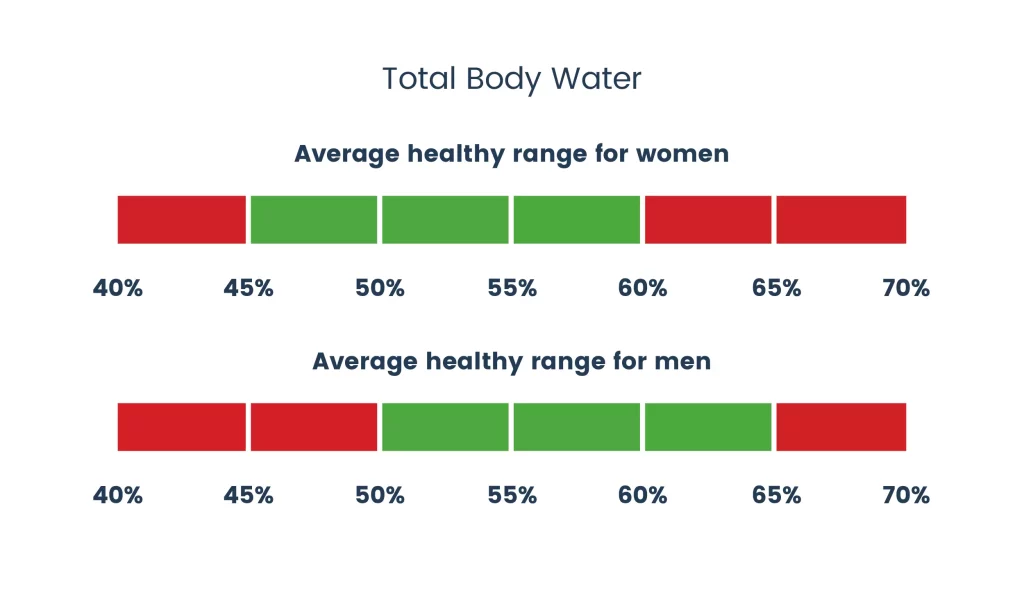
Consequences of not drinking enough water
There are many ways to increase your body water percentage. It starts with drinking at least 2 litres of water per day. Most important: never wait until you are thirsty. Furthermore, it is recommended to start your day with a glass of water. This will clean the body from waste and toxins. Another way to increase your body water percentage is to eat raw fruits and vegetables. They are dense in water. This is a good alternative for drinking water all the time. Keep this in mind: drink water and other fluids until you urinate frequently and with light colour.
Bone mass
The estimated weight of bone mineral in your body.
Healthy bones and a healthy bone mass are important for your body’s strength, movement and load. This is necessary because you have an increase in bone mass up until the age of 30. After this age, the bone mass will slowly decrease. This does not immediately lead to problems, especially if you take care of a good balance in your body. Although it is unlikely that your bone mass will change within a short period of time, you would do well to check this with some regularity. The body analysis scale calculates your bone mass within seconds. This is done using a statistical calculation based on existing studies. These studies have shown that there is a close correlation between the weight of your bones and your lean mass.
You need strong bones
You need strong bones. Until you are about 30, your bone mass will normally increase. However, after that it will start to slowly decrease. That does not have to be as bad as it sounds. If you take good care of your bones they will likely remain dense enough to avoid any issues. If they deteriorate too quickly, or if you had low bone mass to begin with, you are at risk. Bone issues aren’t noticeable until it is too late. It is therefore smart to keep track of your bone mass and check if you are doing well. It is important to keep your bones as strong as possible. Luckily, there are plenty of things you can do to keep your bones healthy and dense.
Nutrients that contribute to good bone mass
A good diet is a big factor contributing to healthy bones. The following nutrients play important roles:
- Calcium
- Vitamin D
- Vitamin K
- Potassium
- Magnesium
Calcium is the most well-known ingredient for strong bones. The nutrient is famously found in dairy, but also in leafy greens such as spinach, beans, fish with bones (sardines, canned salmon), oatmeal and many other foods.
Calcium alone is not enough. Other nutrients are needed for calcium to be able to its job well. For starters, your body needs vitamin D to absorb it. Vitamin D is found in shrimp, fatty fish and eggs. Your body also produces vitamin D when you are exposed to the sun. Many people have too low levels of this vitamin (especially in the winter), so supplementing could be wise.
The next ingredient needed to help calcium strengthen your bones is potassium. Potassium neutralizes acids that break down calcium. It’s in potatoes (don’t remove the skin), sweet potatoes, oranges, yogurt and bananas.
Magnesium is necessary for both calcium and vitamin D to work efficiently. Good sources of magnesium are spinach, tomatoes, potatoes, sweet potatoes and artichokes.
Two other vitamins which are good for your bone mass are vitamin K and C. Eat leafy greens, fruits and peppers and your body will be getting these essential nutrients.Things to reduce or avoid
If you are getting the nutrients above, you are definitely on the right track. However, some things can affect your bone mass negatively. Keep in mind to not overdo it on the following:
- Alcohol
- Caffeine
- Smoking
Alcohol interferes with the working of vitamin D. Caffeine prevents calcium from doing its job properly. Do not despair, you do not need to go cold turkey on alcohol and caffeine. The negative effects on bone mass happen with heavy use. Keep your coffee and alcohol intake moderate, and you should be good.
Smoking prevents the body from effectively absorbing calcium, and therefore decreases bone mass. If you are a smoker, you can add this to the list of reasons to stop.
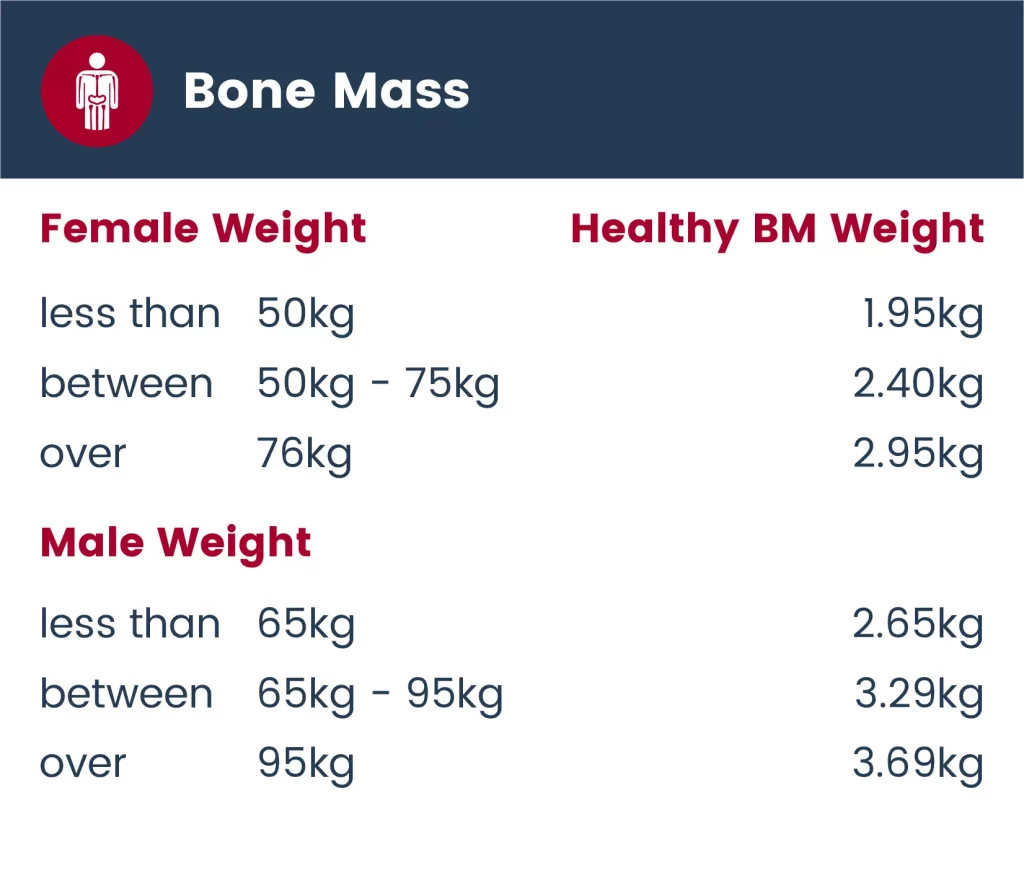
How to keep track of your bone mass
There is no way to know your bone mass without measuring. Our scales send a very small electric current through your body. Since bones, fat, muscle and other tissue all conduct electricity at a different rate, the scale can then calculate your bone mass. Of course, there are more metrics you should know to find out if you are healthy. Our body composition monitor can also tell you your muscle mass, visceral fat percentage, body fat percentage and body water percentage. It can then interpret these data to assess your health and letting you know what you should work on.
Body type
Assesses the percentage of muscle and body fat. This is then classified into one of the nine body types.
When you exercise more, your body weight does not necessarily change much. However, the balance between your body fat and your muscles can change, resulting in a possible change in your posture. Body analysis scales allow you to monitor these ratios and changes closely, so that you can move step by step towards your desired physique. The Tanita body composition scale provides an indication of your body type by comparing measurements of your muscle mass and body fat.
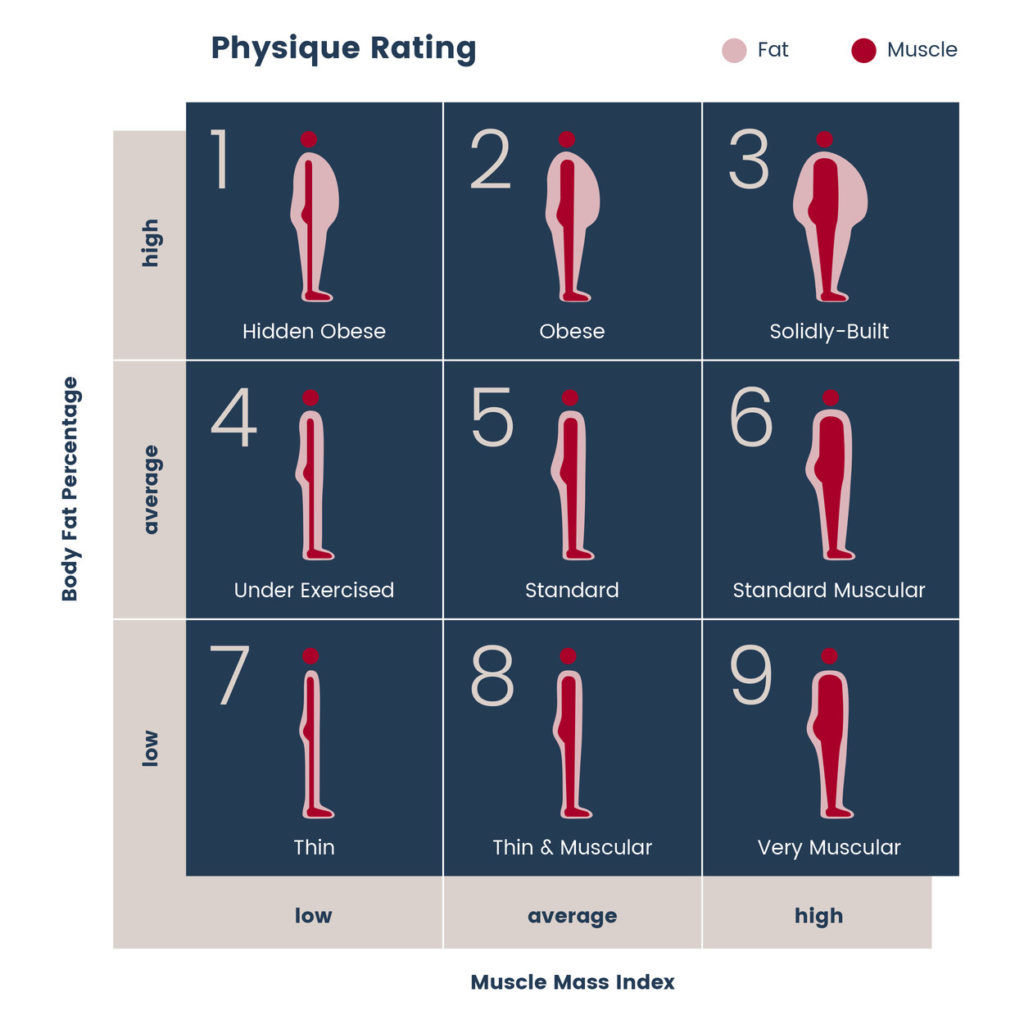
What is physique rating?
Find out what bodytype you have!
The Physique rating assesses muscle and body fat levels. It rates the result as one of nine body types. The Physique rating gives an indication of what type of body you have.
When we start excersising and eating healthier, it can often take a while before we see the actual results. With the physique rating you can get insights in your fat levels and your muscle mass has increased. This also works the other way around. For example when your physical appearance might look good, while your (visceral) fat level has increased. The Physique Rating metric on our Body Composition Monitors gives an indication of your actual performance. With this you can actually start training.
Measuring accurately
In order to assess whether you are at a healthy weight, you need better measurements. At least you’ll want to know your body fat percentage.. It would also be good to know how much of your total body fat consists of visceral fat . To be thorough, your muscle mass is also important to know. And if you really want a complete picture, it would be a good idea to also measure your bone mass and body water levels.
You can measure all of these things at home using our body composition monitor. It sends a small electrical current through your body (don’t worry, you won’t feel it). This allows it to measure all the things mentioned above. Based on your muscle mass and body fat percentage, it will even provide a physique rating. That will give you a clear understanding of what body type you have, much more accurately than BMI can. This allows you to track your health and see progress when you make positive changes to your lifestyle.
Physique Rating 1: Hidden Obese
Hidden Obese means that the body has a high percentage of fat and a low level of muscle mass. Even though you might look like average from the outside, your fat levels are too high. This could lead to obesity, which could lead to serious health problems. By eating healthier and increasing your physical activity you should be able to lower your fat levels.
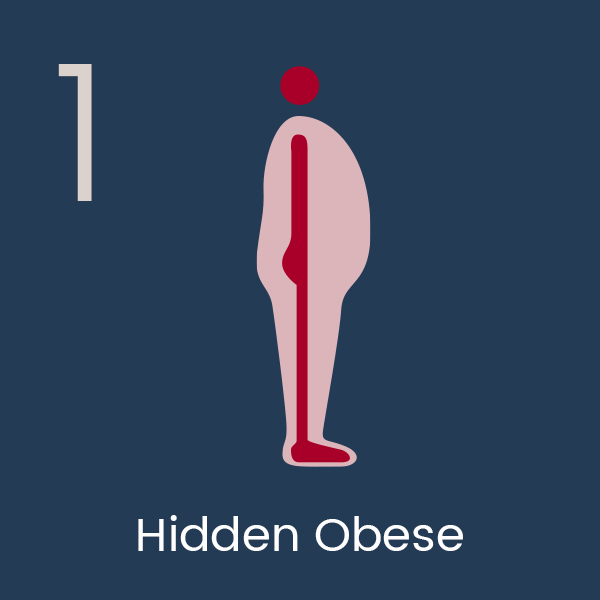
Physique Rating 2: Obese
Obese means that you have a high fat percentage and a standard level of muscle mass. People with an obese physique rating need to be careful. Obesity can lead to serious health problems. Consult a professional to help you when you think you might be obese.
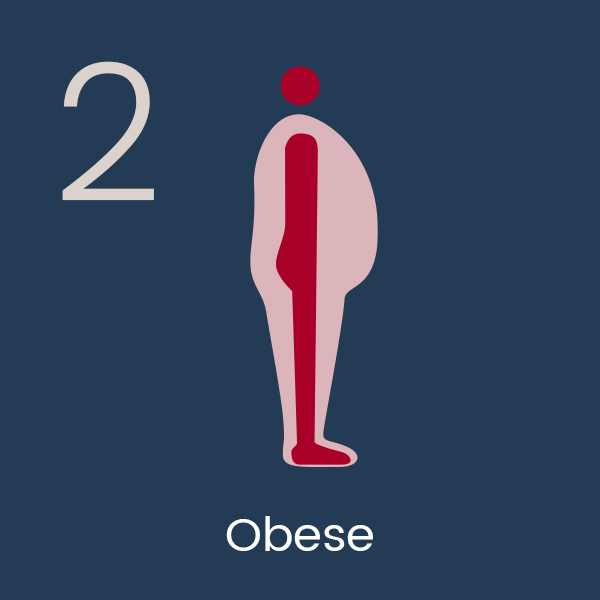
Physique Rating 3: Solidly-built
This means that you have a high body fat percentage and a high muscle mass level. Even tough you might look big on the outside, you actually have a lot of muscle mass underneath.
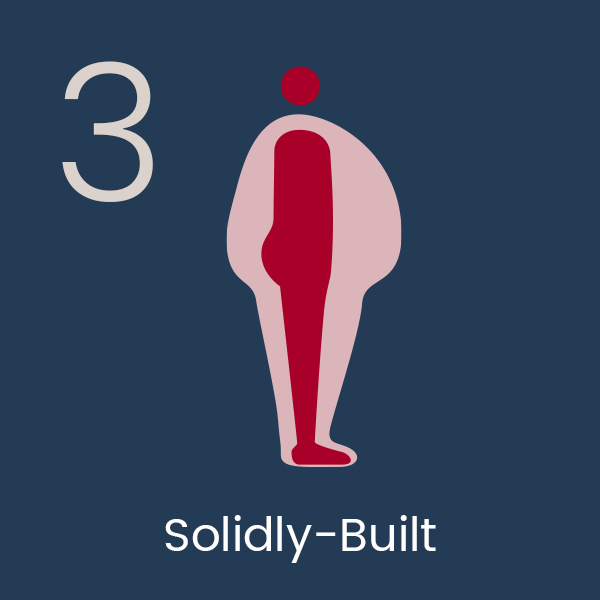
Physique Rating 4: Under exercised
Under exercised means that you have an average amount of body fat and a low muscle mass level. You should start gaining muscle mass by working out regularly.
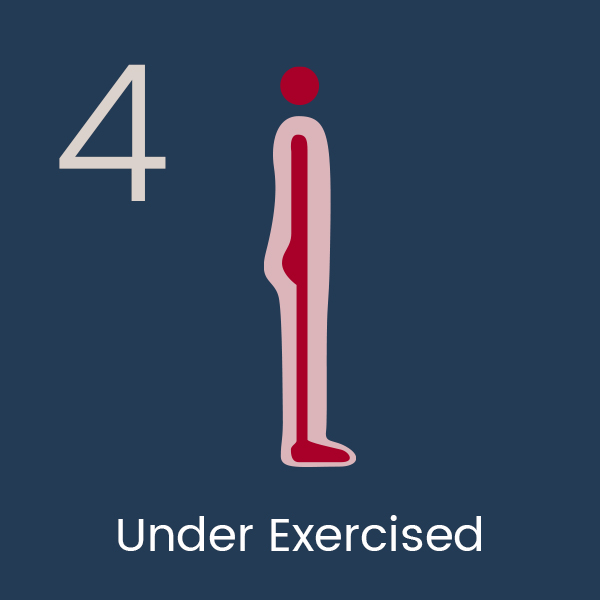
Physique Rating 5: Standard
A standard body type means that you have average levels of both body fat and muscle mass. People with a standard body type can progress a lot when they start working out.
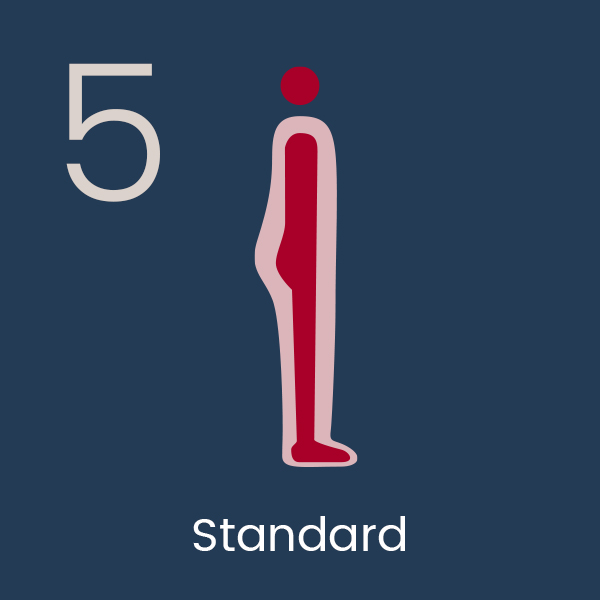
Physique Rating 6: Standard Muscular
This means that you have an average amount of fat percentage and have a high muscle mass level. This is a healthy Physique rating, which you can be proud of. This is a rating which some athletes have.
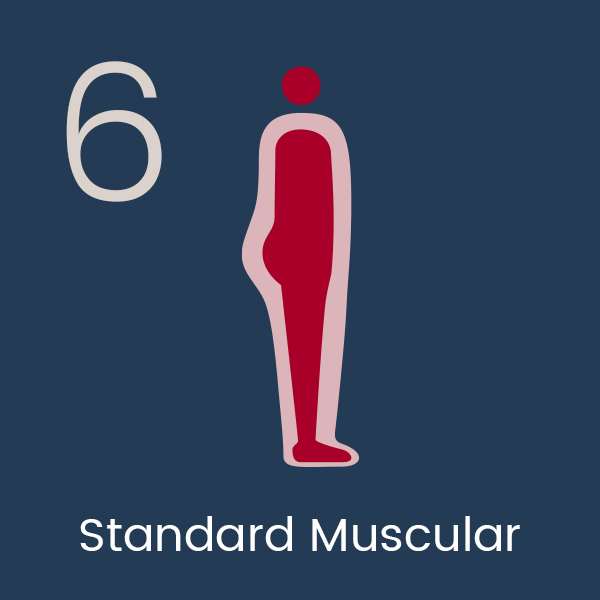
Physique Rating 7: Thin
This means that you have a low amount of body fat and a low muscle mass level. Being too thin could lead to serious health issues, however being a little thin is okay.
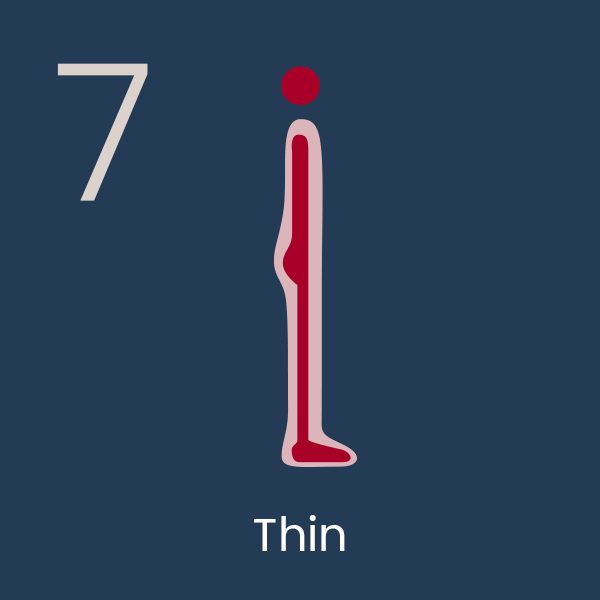
Physique Rating 8: Thin and Muscular
This means that you have a low amount of body fat and a standard level off muscle mass.
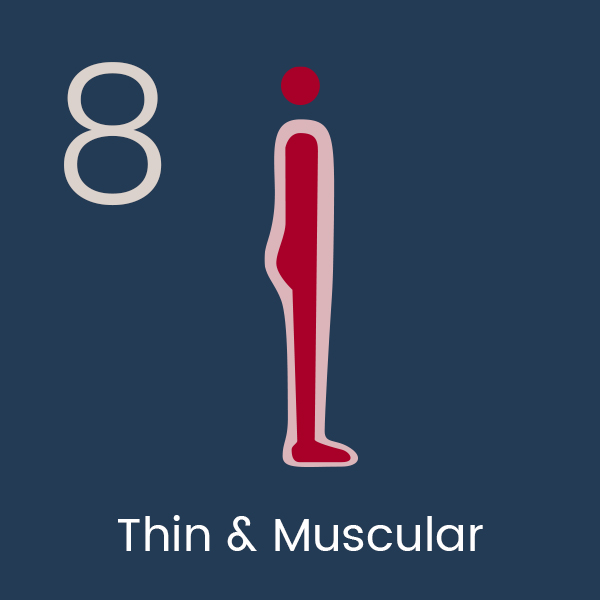
Physique Rating 9: Very Muscular
Very muscular people have a low amount of body fat and a high level off muscle mass.
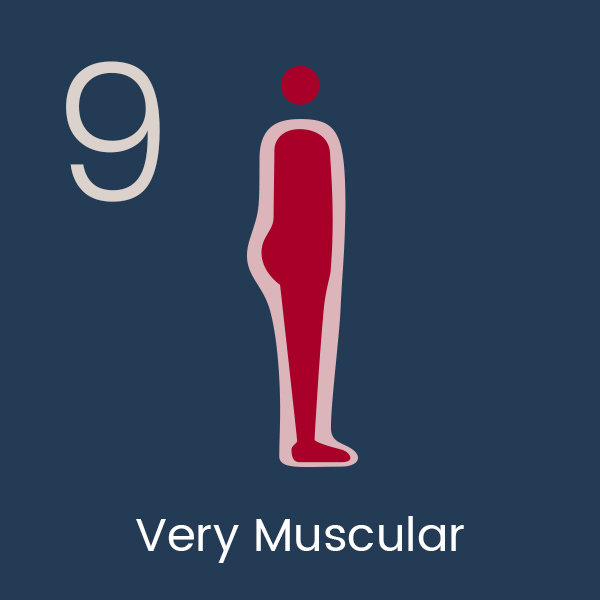
Basal Metabolic Rate (BMR)
BMR (Basal Metabolic Rate) is the minimum amount of energy or calories your body requires daily to function effectively when at rest. This includes sleep.
Basal Metabolic Rate (BMR) is the daily minimum level of energy or calories your body requires when resting, for your respiratory and circulatory organs, neural system, liver, kidneys, and other organs to function effectively. Your BMR is strongly influenced by the amount of muscle you have. Increasing muscle mass increases your BMR, which increases the number of calories consumed and subsequently decreases the amount of body fat.
On the other hand, a lower BMR will make it harder to lose body fat. If you consume fewer calories than you burn, you will lose weight; and vice versa.
The BMR can therefore be used to determine your minimum calorie intake, which can be built up based on the activities during the day. Your BMR score can be easily determined using a body analysis scale. If you follow an intensive training schedule, we recommend that you measure your BMR score regularly.
Basal Metabolic Rate: what is it and how to measure it?
Burn calories while resting!
Basal Metabolic Rate, also known as BMR, is the amount of energy your body burns at rest on a daily basis. In other words: It is the number of calories required to keep your body function while you are not doing any physical activities.
A deeper understanding of Basal Metabolic Rate
Even when you are resting your body is using energy to function effectively. Your body is making your heart pump blood through your veins, for example. Or your stomach is processing the food you just ate. This process is better known as your Basal Metabolic Rate.
Your body consumes almost 70% of the calories to function effectively. Calories are also the first metric people take into consideration when losing weight. Here your BMR can come into play! Increasing your muscle mass helps your BMR. By gaining more muscles the number of calories you burn increases. And this will help you to decrease body fat. Your BMR measurement can be used as a baseline for a diet programme. Extra calories can be included depending on your level of activity. The more active you are the more calories you will burn. Next to this you’ll build more muscle mass. This means that you need to keep an close eye on the amount of calories you consume. to keep your body fit and healthy.
Metabolic age
As people age, their metabolic rate changes. Basal metabolism rises as a child matures and peaks at around 16 or 17, after this point it typically starts to decrease. A low BMR means you have to eat less calories in order to lose body fat and weight.
The Metabolic age is calculated by comparing your Basal Metabolic Rate to the average BMR of your chronological age group. If your metabolic age is higher than your actual age, it’s an sign that you need to improve your metabolic rate. Increased exercise will build healthy muscle tissue, which in turn will improve your metabolic age. Keeping track of your metabolic age will give you an sign when its best to gain more muscle mass.
Metabolic age
Your metabolic age compares your BMR with the average of your age group.
The metabolic age is the result of the comparison between your BMR and your chronological age group. If your metabolic age is higher than your actual age, this may indicate that your metabolism is not as efficient as it could be. You can check this with a body analysis scale. By exercising more you can improve your muscle growth, which will benefit your BMR. A regular check-up is essential here.
Basal Metabolic Rate: what is it and how to measure it? Burn calories while resting!
Basal Metabolic Rate, also known as BMR, is the amount of energy your body burns at rest on a daily basis. In other words: It is the number of calories required to keep your body function while you are not doing any physical activities.
A deeper understanding of Basal Metabolic Rate
Even when you are resting your body is using energy to function effectively. Your body is making your heart pump blood through your veins, for example. Or your stomach is processing the food you just ate. This process is better known as your Basal Metabolic Rate.
Your body consumes almost 70% of the calories to function effectively. Calories are also the first metric people take into consideration when losing weight. Here your BMR can come into play! Increasing your muscle mass helps your BMR. By gaining more muscles the number of calories you burn increases. And this will help you to decrease body fat. Your BMR measurement can be used as a baseline for a diet programme. Extra calories can be included depending on your level of activity. The more active you are the more calories you will burn. Next to this you’ll build more muscle mass. This means that you need to keep an close eye on the amount of calories you consume. to keep your body fit and healthy.
Metabolic age
As people age, their metabolic rate changes. Basal metabolism rises as a child matures and peaks at around 16 or 17, after this point it typically starts to decrease. A low BMR means you have to eat less calories in order to lose body fat and weight.
The Metabolic age is calculated by comparing your Basal Metabolic Rate to the average BMR of your chronological age group. If your metabolic age is higher than your actual age, it’s a sign that you need to improve your metabolic rate. Increased exercise will build healthy muscle tissue, which in turn will improve your metabolic age. Keeping track of your metabolic age will give you an sign when its best to gain more muscle mass.
Body Mass Index
A standardised ratio of weight to height, used as a general indicator of health.
The Body Mass Index (BMI) is a widely used health indicator. It can be roughly calculated by dividing your body weight (in kilograms) by your height (in metres) squared. If the resulting figure is less than 18.5, you are underweight. A number between 18.5 and 25 indicates a healthy weight. A number above 25 is overweight and a number above 30 is obese. Although the BMI is a generally accepted health indicator, it is not the only one. For example, someone with a lot of muscle mass can have a high BMI without being unhealthy. By looking at the ratio of muscle to fat mass, among other things, you get a much better understanding of your health.
A very rough indication
Body Mass Index (BMI) is the most well-known measurement of the level of fat in your body. It is easy to calculate: just divide your weight by the square of your height. This provides you with a number which indicates whether you are underweight, at a normal weight, overweight or obese.
However, don’t be too quick to draw conclusions about your health based on this. BMI is not very reliable at the individual level. Read on to understand why this is the case and what you can do to get a better understanding of your fat percentage.
Why BMI was developed
In the 19th century, Western societies were starting to get more prosperous. For the first time, food was plentiful and obesity was on the rise. The Body Mass Index was devised to keep tabs on the increasing levels of obesity in these populations. When used like this, for large groups, it is reasonably accurate.
Originally, BMI was not meant for assessing individuals. However, it is easy to calculate and requires no measurements besides height and weight. Because it is so simple, it has been used a lot to quickly determine whether someone is at a healthy weight.
Why BMI was developed
For those who are of average height and inactive, BMI offers a reasonable indication. However, people’s body types vary a lot. For many, BMI does not accurately represent their body fat percentage. For example, tall people are often more slender in proportion to their height than shorter people. Therefore, their BMI is higher than their actual body fat percentage would warrant. Based on their BMI, they may be seen as overweight, even though they are not. On the other end of the spectrum, shorter people often have a lower BMI than they should have, based on their body fat percentage.
The Body Mass Index also does not take muscle into account. Muscle is heavier than fat. Therefore, a bodybuilder can be classified as obese, even though he has a very low fat percentage. This goes both ways. Someone who is slender and has very little muscle might think, based on BMI, that he is not overweight. However, they can still have an unhealthy amount of body fat.
Imagine you decide to start going to the gym. You might be losing fat, but not see any change to your BMI. What your BMI is not telling you, is that you are gaining muscle at the same time. Getting the impression that you are not improving can be very demotivating.
Finally, BMI does not differentiate between types of body fat. Visceral fat is more of a health issue than the fat under your skin. When assessing your health, it is valuable to be aware what percentage of your fat is visceral.
Measuring accurately
In order to assess whether you are at a healthy weight, you need better measurements. At least you’ll want to know your body fat percentage. It would also be good to know how much of your total body fat consists of visceral fat. To be thorough, your muscle mass is also important to know. And if you really want a complete picture, it would be a good idea to also measure your bone mass and body water levels.
You can measure all of these things at home using our body composition monitor. It sends a small electrical current through your body (don’t worry, you won’t feel it). This allows it to measure all the things mentioned above. Based on your muscle mass and body fat percentage, it will even provide a physique rating. That will give you a clear understanding of what body type you have, much more accurately than BMI can. This allows you to track your health and see progress when you make positive changes to your lifestyle.
